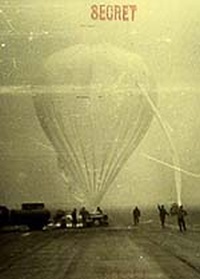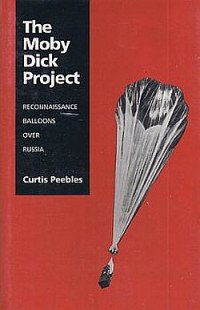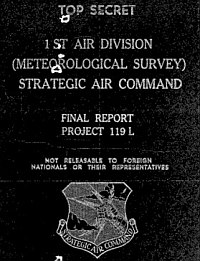News Archive
A personal memory

Since the start of StratoCat in 2005 I've planned to write an article about Genetrix's fascinating story, but always ended making merely a rehash of the existing works elsewhere, something that did not convince me much. In the process of searching more information on the subject I've found "UFX" a fantastic website created by Joel Carpenter which documented very well the impact of the 50's and 60's technology on the UFO myth and the culture. UFX offered a glimpse to a fringe world ranging from weird projects that never left the drawing boards to strange machines that would populated the vasts battlefields of a future third world war. Of course, including reconnaissance balloons.
I've contacted him, and we started to exchange a lot of mails on the topic, developing some kind of friendship in the distance fueled by our mutual interest. He even got me a copy of the Peebles book that was unfortunately lost somewhere by the Argentinian post office and never arrived home. Still, when I needed some data or information he took the job to scan countless pages of the book. Other times, we shared some weird finding or theory.
It was a shock for me to learn of his sudden death in March 2014.
I want to imagine that if he had the chance to read these pages, although he would not have discovered anything he did not already know, he would have enjoyed them.
Go this memory to Joel, a friend in the distance...
-
June 3 2017
GENETRIX spy balloon program data published in StratoCat
After a six month work and a search that endured almost 10 years, I'm publishing today in StratoCat for the first time an extensive and comprehensive bulk of information about a secret program carried out by the US Air Force and other agencies to obtain strategic reconnaisance of the Soviet Union and their allies.

GENETRIX, also known as Project 119L and by other code names that reflected different phases of the program like "Gopher", "Grandson" and "Grayback" was a secret program started in 1950 and executed in 1956 by the United States Strategic Air Command (SAC) and other agencies, under the cover of a meteorological and scientific effort.
However, the real objective was to obtain photographic reconnaissance of the Soviet Union using high resolution cameras transported by stratospheric balloons riding the jet stream.
With satellites still ahead in the future and the U2 spy plane barely rising from the drawing boards of Kelly Johnson's Skunk Works, the initiative was for the times a pioneering one. The desperate search for information of that "black box" behind the Iron Curtain, and specially the need of reliable information on strategic capabilities of the potential enemy, gave birth to one of the most complex programs of the early cold war.
After years of preparation, the program received on January 10, 1956 the go ahead of Presint Eisenhower to start launching the balloons from sites in Scotland, Norway, Germany and Turkey. The balloons swept the Soviet and Chinese territory in a west-east direction in seven to ten days, and once reaching the Pacific Ocean, they were separated from their gondolas which were recovered while descending in parachute by specially fitted planes. Of the originally plans to send 2500 balloons merely 516 were launched on the 27 days that endured the effort. Angry protest from the Soviets and the low number of payloads recovered, led to the termination of the program in early February. The soviet protest included -as usual- a great propaganda move which took place in the evening of February 9 with the exhibition on the Spiridonvka Palace in Moscow of dozens of Genetrix payloads, balloons envelopes, cameras, ballast boxes and exposed pictures.
Below these lines there is a brief reel from British Pathe of that press conference.
Despite the embarrasing end, Genetrix pushed greatly the advance of balloon systems and also laid the foundation for future reconnaisance missions of the U2 high altitude plane and satellites like the Discoverer/Corona series, whose techniques of catching the descending payloads in mid-air, and the high resolution cameras were developed initialy for the balloon program.
GENETRIX went public
During many years, the program remained in the shadows of the higher spheres of the reconnaissance community and under the secrecy sworn by their participants.

In 1991, after the declassification of documents and reports on the program, and a huge amount of research, the aerospace historian Curtis Peebles would publish his book "The Moby Dick Project - reconnaissance balloons over Russia", which still today is the most detailed account on the program. The book surfaced the program to the eyes of the general public and served as principal source of several articles on the subject that saw the light over the Internet in the decades following.
After many years of searching, in early 2016 I finally managed to get a copy of Peebles' book. It was such a huge piece of literature, that not only covered in detail the Genetrix effort but also shed light over several other programs that served to train personnel that would take part of the reconissance effort or were used to boost the scientific cover history. I think I've read it entirelly two or three times. The only minor flaw of the book -for a balloon freak as me- is the lack of records of the balloons launched. Obviously, for an adequate telling of the history of such a complex program, it was wise not to overwhelm the reader with pointless data. Nevertheless, from the point of view of my research on the subject, that kind of information is fundamental as StratoCat is a project which was born to offer detailed data for every single stratospheric balloon that was launched around the world since 1947, either for scientific or military. However, my luck was about to change.
The discovery
I am a regular visitor of online repositories of grey literature (NASA's NTRS, DTIC, NTIS, and many more) as these are the best places to obtain open access and reliable data on ballooning. Last January I was on the online FOIA reading room of the Central Intelligence Agency, looking at the latest additions when suddenly, I was struck by a small title.
Immediately I felt as if I had found a little forgotten treasure.

The 510 pages document was the final report on "Project 119L" approved for release in June 2011, but which was published online merely a month before.
In addition to a detailed account of the preparations, logistic effort, and many significant details of the development of the operational phase of the program, the document also contained as the last annex a cryptic table 17 pages long, that after a few hours of careful reading turned out to be the complete list of the more than 500 Genetrix balloons launched back in 1956.
As soon as I've realized what I've found commenced to gather all the information I've compiled over the years. Then, using data from the final report and the Peebles' book as a guide to clean-up the somewhat messy flow of a military document, six months later, I've managed to add all this information published to StratoCat.
Where to find it
A comprehensive account of the entire program is available on the Genetrix Project entry of the stratopedia, the scientific ballooning encyclopedia (sort of, a little pompous title).
There is also a description of the WS-119L Reconnaisance payload carried by each balloon along with the complete list of flights.
Regarding the launch sites, on the section of balloon launch bases around the world, I've added five new pages for each one of the military bases used by the Genetrix program:
- Adana Air Base, Turkey
- Evanton Naval Air Station, Scotland
- Gardermoen Air Force Base, Norway
- Giebelstadt Airfield, Germany and
- Oberpfaffenhoffen Airfield, Germany
Finally, the entire list of flights with detailed descriptions and external links to more data were also included in the Launches by Year section corresponding to 1956.
There is still a lot of information to be classified, which I will incorporate in the near future, especially regarding the related programs to Genetrix.
The publication of all this information, is for me personally, a small achievement but also has a bitter side, for the memory of a friend who is no longer with us and who surely would have shared and understood my enthusiasm. A small remembering of him is in the column at left.
-
Share this on social media


